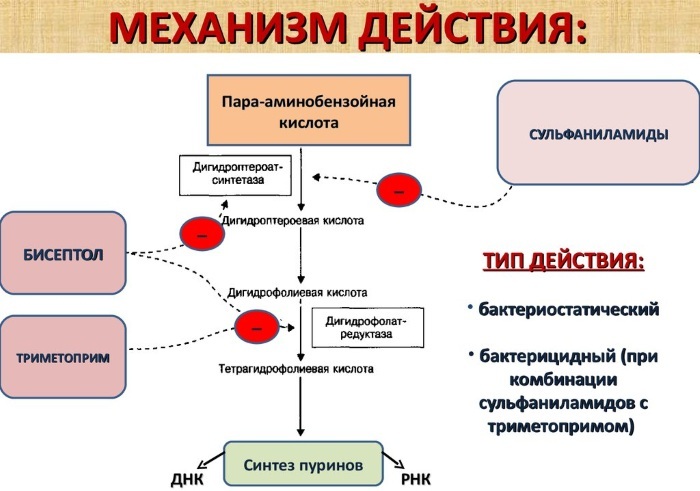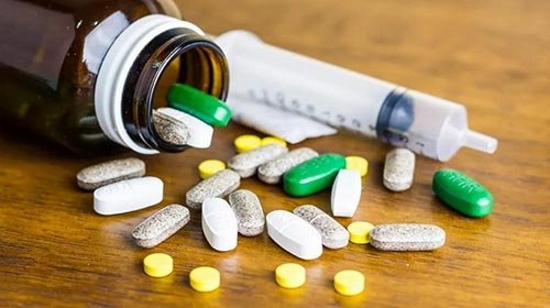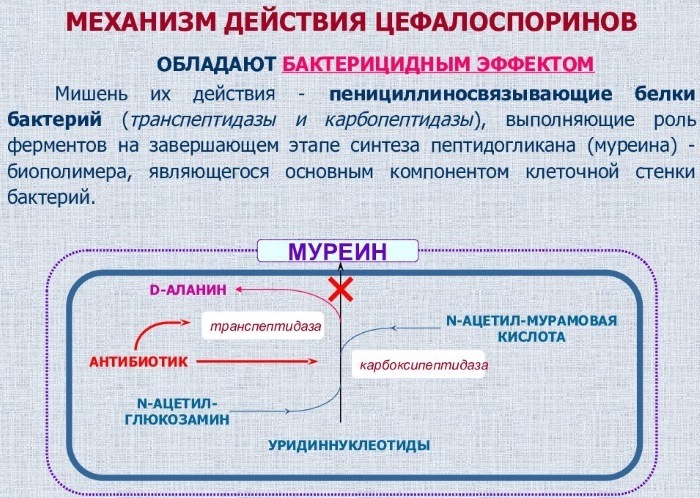Cephalosporins are a type of antibioticthat treat bacterial infections. These drugs are divided into classes and are a type of beta-lactam antibiotic. Preparations of the 3rd generation are more effective against gram-negative bacteria compared to the first and second generation. The medicine is available in both powders and tablets.
Record content:
- 1 Characteristic
-
2 Rating of drugs from the pharmacy
- 2.1 Suprax
- 2.2 Zedex
- 2.3 Panzef
- 2.4 Spectraceph
- 2.5 Claforan
- 2.6 Ceforal Solutab
- 2.7 Rocefin
- 2.8 Fortum
- 2.9 Sulbactam
- 3 Video about cephalosporins
Characteristic
Cephalosporins are a large group of antibiotics derived from the Acremonium mold. Representatives of this group are bactericidal (kill bacteria) and act similarly to penicillins.
They bind and block the activity of enzymes responsible for the conversion of peptidoglycan, an important component of the bacterial cell wall. They are called broad-spectrum antibiotics because they are effective against many bacteria.
Most of the available cephalosporins are semi-synthetic derivatives of cephalosporin C, a compound with antibacterial activity produced by the fungus Cephalosporium. In clinical practice, these antibiotics are grouped into five "generations" depending on their spectrum of action against aerobic and facultative gram-negative and gram-positive bacteria.
The main advantage of third-generation antibiotics is the increased coverage of gram-negative bacteria.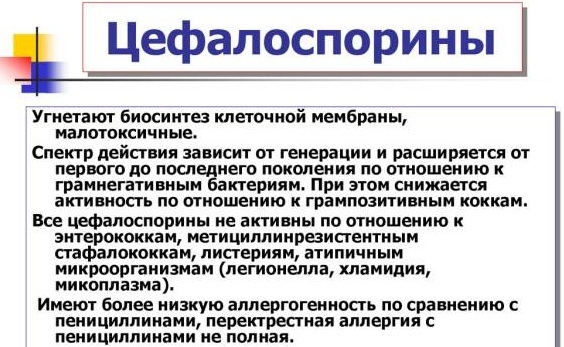
In addition, the third-generation cephalosporin ceftazidime is active against Pseudomonas aeruginosa, a bacteria that can cause skin infections in people with normal the immune system (for example, after exposure to insufficiently chlorinated pool water), as well as pneumonia and blood infections in people with weakened immune systems system.
3 generation cephalosporins in tablets, powders, injection solutions, are used to treat the following types of infections caused by sensitive strains of bacteria:
- Bacteremia due to sepsis.
- Infectious bone and joint diseases.
- Central nervous system infections.
- Gynecological infections.
- Intra-abdominal infections.
- Lower respiratory tract infections.
- Bacterial skin lesions.
- Urethral infection.
β-lactam drugs are not usually used as a second choice antibiotic. They are used when other antibiotics (penicillin) cannot be used.
3rd generation cephalosporins (tablets, powders for preparation of solutions) are generally safe, have low toxicity and are effective against sensitive bacteria.
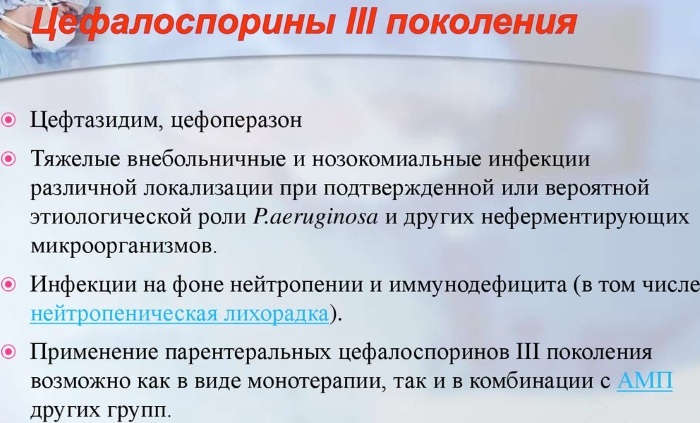
Side effects caused by cephalosporins:
- Gastrointestinal. Common side effects include diarrhea, mild stomach cramps or upset, nausea and vomiting.
- Hematological disorders:
- hypoprothrombinemia (deficiency of prothrombin in the blood) is characteristic of cefoperazone, cefamandole, cefotetan, cefmenoxime;
- thrombocytopenia (low platelet count);
- neutropenia (low neutrophil count);
- leukopenia (decrease in the number of leukocytes).
- A disulfiram-like reaction (hot flashes, sweating, headache, tachycardia) can occur when the simultaneous use of alcohol and methyl-containing cephalosporins (cefoperazone, cefamandol, cefotetan).
- Hepatic toxicity is rare and usually results in elevated transaminase levels.
- Allergic reactions occur mainly in the form of a rash (maculopapular, urticaria), eosinophilia, drug fever. Other hypersensitivity reactions, such as anaphylaxis, a serum sickness-like reaction, or angioedema, are rare.
More serious but infrequent reactions include:
- black, tarry stools;
- painful or difficult urination;
- antibiotic-induced colitis (severe watery diarrhea, severe stomach cramps, fever, and weakness).
Cephalosporins can also cause overgrowth of the fungus normally found in the body. Also, a temporary increase in the activity of liver enzymes was noticed after taking antibiotics.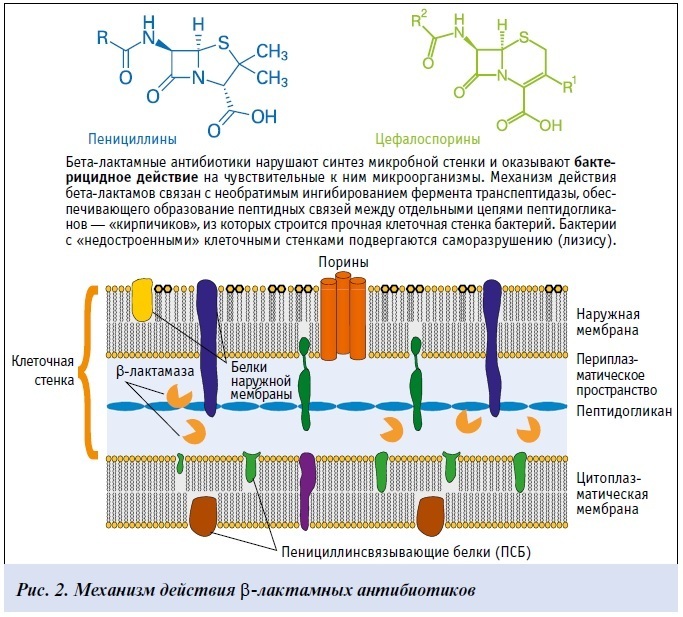
3rd generation cephalosporins have more favorable pharmacological properties than previous generations of antibiotics. Preparations in tablets, in the form of suspensions, should be taken exactly as directed.
3rd generation drugs have 2 subgroups:
- cefotaxime group;
- a group of ceftazidimes.
| Oral intake | Preparations for injection | |
| Cefdinir Cefditorin |
capsules, suspension, tablets | Cefoperazone Cefotaxime Ceftizoxime Ceftriaxone Ceftriabol Ceftazidime |
| Cefixime | tablets, suspension | |
| Cefpodoxime | tablets, suspension | |
| Ceftibuten | capsules, suspension | |
| Cefdinir | capsules, tablets |
Third-generation cephalosporins have a pronounced activity against gram-negative bacteria, increased stability of beta-lactamase and the ability to penetrate gram-negative cell walls.
Rating of drugs from the pharmacy
Cephalosporins of the 3rd generation in tablets are produced much less frequently than the same preparations in the form of a powder for solutions and lyophilisates.
Suprax
A semi-synthetic antibiotic that penetrates well into the focus of infection, for diseases in the ear, paranasal sinuses, inflammation of the tonsils.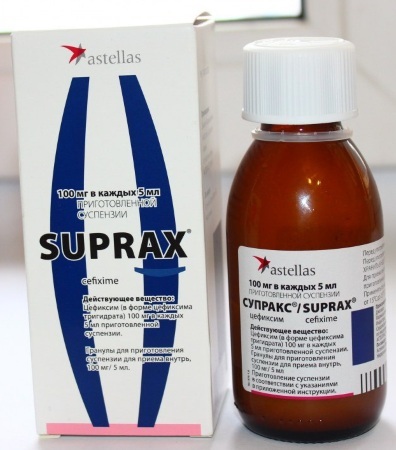
| Active substance | cefotaxime |
| Release form | Film-coated tablets containing 400 mg of the drug, capsules containing 400 mg; chewable tablets, 100, 150 and 200 mg; oral suspension, 100 mg / 5 ml, 200 mg / 5 ml and 500 mg / 5 ml. |
| Indications | Uncomplicated urinary tract infections, otitis media, infection of the pharyngeal mucosa, tonsillitis, exacerbation of chronic bronchitis, uncomplicated gonorrhea (cervical, urethral) |
| Contraindications | Symptoms of an allergic response to the active substance and other constituent components of the drug. |
| For adults, the recommended dose is 400 mg per day. A 400 mg tablet or capsule is taken daily, the tablet form can be divided into 2 parts and taken every 12 hours. For the treatment of uncomplicated urethral gonococcal infections, a single dose of 400 mg is recommended. Taking capsules and tablets does not depend on food intake. Therapy for diseases caused by beta-hemolytic streptococci (tonsillopharyngitis, rheumatic fever) lasts 10 days. | |
| Pediatric patients (from 6 months) | From 6 months up to 1 year: 2.5-4 ml / day, up to 4 years: 5 ml / day, up to 12 years old 10 ml / day. |
Compared with other cephalosporins, the drug has little effect on the intestinal flora. The price of the medicine is from 500 to 800 rubles. for granules and tablets, respectively.
Zedex
Of the entire group of drugs of the 3rd generation, this drug has the least resistance to β-lactamases, the greatest activity is shown to gram-negative flora, and less to staphylococci and pneumococci sensitive.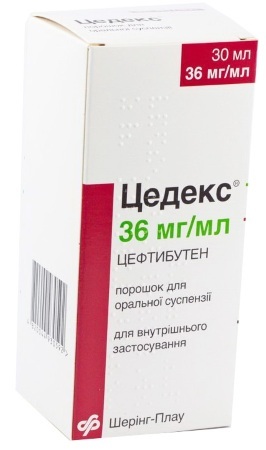
| Active substance | ceftibuten |
| Release form | Capsules with a volume of 400 mg, as well as powder for suspension preparation. |
| Indications for use | Chronic bronchitis during an exacerbation, acute respiratory infections, otitis media, sinusitis, community-acquired pneumonia, acute uncomplicated urinary tract infections. |
| Contraindications | Allergic reactions to the components of the drug, cross-reactions with penicillin drugs, chronic colitis |
| Doses | The action of the drug does not depend on food intake, it is recommended 400 mg / day one time, in some cases, the intake is divided into 2 times. |
| Childhood | From 6 months up to 10 years 9 mg / day per 1 kg of body weight, 1 time per day, but not more than 400 mg / day. From 10 years old, children take the adult dose. The suspension is taken 1 hour before or after a meal, diluted according to the instructions. |
| Pregnant women and nursing mothers | Use with caution, although the penetration of the active substance into breast milk has not been recorded in laboratory studies of the drug. |
The cost in pharmacy chains is 500–600 rubles. for 36 mg of powder for suspension, and from 800 rubles. for 400 mg capsules.
Panzef
Cephalosporins of 3 generations in tablets are represented by the antibiotic drug Pancef.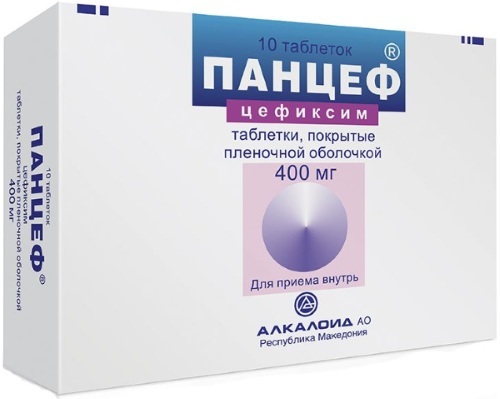
| Active substance | cefixime |
| Release form | Tablets containing 400 mg of the substance, capsules for suspension preparation with a volume of 60 and 100 ml |
| Indications | Acute uncomplicated urinary tract infections, acute otitis media, bacterial infections of the upper, lower respiratory tract, chronic inflammatory diseases of the bronchi during the period of complications, gonorrhea uncomplicated. |
| Contraindications | Individual intolerance to the components of the drug, pregnancy, breastfeeding period. |
| Doses | 400 mg / day at a time, if desired, can be divided into 2 doses, the course of treatment is on average 1-2 weeks |
| Childhood | It is not used until the age of 6 months, after this age the doses are calculated on the basis of 1 kg of weight: 3-9 mg per 1 kg, but not more than 12 mg per 1 kg of weight. |
Panceph in some cases causes an increase in nitrogen in urea, shortness of breath. The cost of the drug in pharmacies is from 400 to 600 rubles.
Spectraceph
Semi-synthetic beta-lactam antibiotic. It is a prodrug of cefditoren.
| Active substance | cefditorin |
| Release form | Tablets containing 200 or 400 mg of active substance |
| Indications | Acute sinusitis, tonsillopharyngitis, lower respiratory tract infections, infected uncomplicated skin wounds, boils, abscesses, community-acquired pneumonia. |
| Contraindications | With increased sensitivity to the components of the drug, hemodialysis, pregnancy, during the period of feeding the child, children under 12 years of age, in the case of liver failure of class C, the drug is not recommended. Elderly people should take the medicine with caution. |
| Doses | It is advisable to take after meals, the interval between doses is strictly 12 hours. Bacterial respiratory tract infections: 200 mg every 12 hours within 10 days. Chronic bronchitis during an exacerbation: 200 mg daily for 10 days. Community-acquired pneumonia: 200 mg daily for 2 weeks. |
In pharmacy chains, the price of the drug starts from $ 1,000. rub. for 20 pcs. tablets of 200 mg. The cost is 10 tab. 400 mg from 1 thousand RUB 500
Claforan
A cephalosporin antibiotic belonging to the 3rd generation has a bactericidal effect on the body.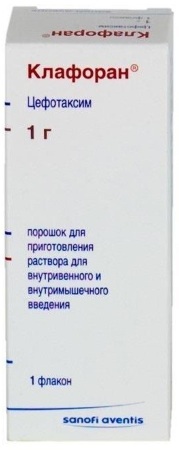
| Active substance | cefotaxime |
| Release form | Powder for injection. |
| Indications for use | Severe infectious diseases of organs and systems: inflammatory response of the body due to sepsis, ENT, infectious diseases of the respiratory, urinary tract, kidneys, skin and soft tissues, bones and joints, genitals, abdominal cavity, meningitis, progressive Lyme disease (especially stages II and III). |
| Impact | An extended spectrum of activity in the case of gram-negative pathogens, but not very effective in the case of damage by gram-positive microorganisms. |
| Contraindications | Heart failure, allergic reactions to the active ingredient or any of the additional parts, in case of increased sensitivity to penicillin, attention should be paid to the possible cross allergies. |
| Pregnancy, breastfeeding | Can only be used to a limited extent with rigorous risk and benefit assessment, during lactation, the medicine is contraindicated. |
| Standard dose | Mild infections when the susceptible pathogen is known: 1–2 g every 4–12 hours. Moderate infections, with multiple pathogens: 2 g intravenously. Life-threatening infections: 6–12 g / day intravenously, injections divided into 3–6 single doses. |
| Children (under 2.5 years of age, the drug is contraindicated) | |
| Indications | Respiratory and ENT infections, cystitis, pyelonephritis, abdominal infections, including peritonitis, pre and postoperative prevention, skin and soft tissue infections, osteomyelitis, meningitis, sepsis (newborn) Lyme disease (stages 2 and 3) |
| Dose | It is calculated per 1 kg of the child's weight, the highest dose is 180 mg per day. |
The price of the drug in pharmacies is 164 rubles. for 1 g of powder for solution preparation. The diluted medicine is administered intravenously or intramuscularly.
Ceforal Solutab
The drug is a broad spectrum of activity, semi-synthetic, intended for oral administration.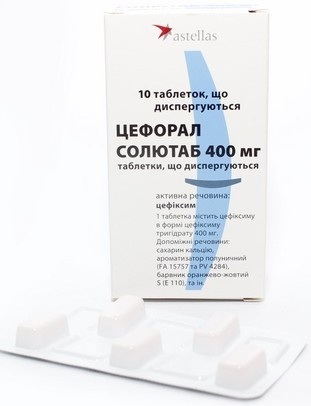
| Active substance | cefixime |
| Release form | Tablets 400 mg |
| Indications | Uncomplicated diseases of the urinary tract caused by infections, otitis media, tonsillitis, based on streptococcal infection, pharyngitis of the same etiology, uncomplicated gonorrhea, shigellosis, sinusitis. |
| Contraindications | Childhood renal failure in chronic form, individual intolerance to the components of the drug, breastfeeding of the baby. Use with caution during pregnancy, in case of renal failure |
| Doses | Food intake has no effect on the drug, the daily dose is applied once or can be divided into 2 times, the total dose is 400 mg / day. The course of treatment: ENT diseases up to 14 days, diseases caused by streptococci - up to 10 days, upper and lower urinary tract infections - from 3 days to 2 weeks. |
| Children weighing from 25 to 50 kg | 200 mg / day at a time. |
Elderly patients should be prescribed the drug with caution, paying attention to concomitant diseases. The cost of 10 tablets is 630-700 rubles.
Rocefin
Semi-synthetic antibiotic with a broad effect on gram-negative, gram-positive microorganisms. The medicine is administered intravenously or intramuscularly.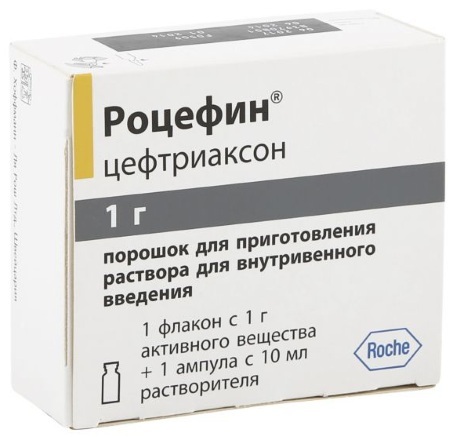
| Active pharmaceutical ingredient | ceftriaxone |
| Indications | Bacterial infections of various systems and organs: sepsis, respiratory tract, ENT, kidneys and urinary tract, skin and soft tissues, bones and joints, genitals, abdominal cavity, meningitis. Progressive Lyme disease (especially stages II and III) Perioperative prophylaxis. Therapy of uncomplicated gonorrhea, ascending infection with gonorrhea, disseminated gonococcal infection. |
| Contraindications | Hypersensitivity to the active ingredient or any of the accessory ingredients. In case of hypersensitivity to penicillin, attention should be paid to possible cross-allergy. |
| Standard dose | 2 g / day, once, maximum dose 4 g / day |
| Pregnancy and breastfeeding | The use of pregnant women is allowed, but limited use in the 1st trimester with a strict assessment of the risks and benefits. Lactation: Can be used if the spectrum of bacteria requires it. |
| Use for children under 12 years old | |
| Dose | Newborns up to 2 weeks of age: 20 to 50 mg per kg of body weight, once a day. For infants and older up to 12 years: from 20 to 80 mg per 1 kg of body weight 1 time / day. |
The drug has a high resistance to most beta-lactamases. In rare cases, after administration of the solution, a change in prothrombin time is observed. Price from 490 RUR
Fortum
The antibiotic has a wide range of effects, is available in the form of a soluble powder for injection, intramuscular and intravenous.
| Active substance | ceftazidime |
| Indications | Severe infections in the respiratory tract, kidneys, urinary tract, skin, soft tissues, bones, joints, genitals, in the gastrointestinal tract. Recommended in case of peritonitis, lesions in the central nervous system, ENT. Infections during dialysis treatments. |
| Effects on microbes | Good activity against Pseudomonas aeruginosa. Less effective against gram-positive pathogens |
| Contraindications | Hypersensitivity to the active or additional ingredients, newborn children, impaired renal function, ulcerative colitis. |
| Standard dose | Moderate to severe infections: 1 g daily or 2 g intravenously daily. Life-threatening immunosuppressive infections: 2 g per day. The maximum dose is 6 g per day, in exceptional cases it is possible to increase the dose to 9 g per day. |
| Pregnancy and lactation | There is not enough data on the effects on the body during the period of bearing a child. Not recommended for use while breastfeeding. |
The duration of therapy is 1-2 weeks. Elderly patients are not recommended to use more than 3 g of Fortum per day. The price of the drug is from 90 to 180 rubles. for 0.5 g and 1 g, respectively.
Sulbactam
Inhibitor-protected cephalosporin, which is a combination of cefoperazone and sulbactam. It is more often used in monotherapy for diseases of the abdominal cavity, pelvic organs caused by infections.
| Active substance | cefoperazone |
| Release form | Dry powder used for the preparation of intravenous, intramuscular injections. |
| Indications | Severe infections of the joints and bones, bacterial diseases of the upper, lower respiratory tract, skin, genitourinary system, pelvic organs, abdominal cavity, meningitis, which has bacterial etiology. |
| Contraindications | Allergic reaction to the composition of the drug, for functional disorders of the kidneys and liver, it is used with caution. |
| Doses (doses are prescribed strictly according to indications) | From 3 to 8 g / day is administered parenterally every 12 hours. equal doses meningitis: from 12 to 16 g / day in 4 administration sessions acute gonorrhea: once intramuscularly 0.5 g. |
| Children's doses | The duration of treatment and doses are set individually, taking into account the severity of the disease. Use in newborns is possible. |
| Pregnancy and breastfeeding | The drug is used as directed by a doctor, if necessary. |
The cost of the drug is low, 150-200 rubles. for 1 bottle containing 1 thousand mg of powder.
The 3rd generation cephalosporins in tablets are well tolerated and effective. In medical practice, they are considered as second or third choice therapy. They are most often used when other beta-lactams cannot be used for people with allergies or in the presence of several pathogenic microorganisms.
Video about cephalosporins
Basic pharmacology of beta-lactams:

